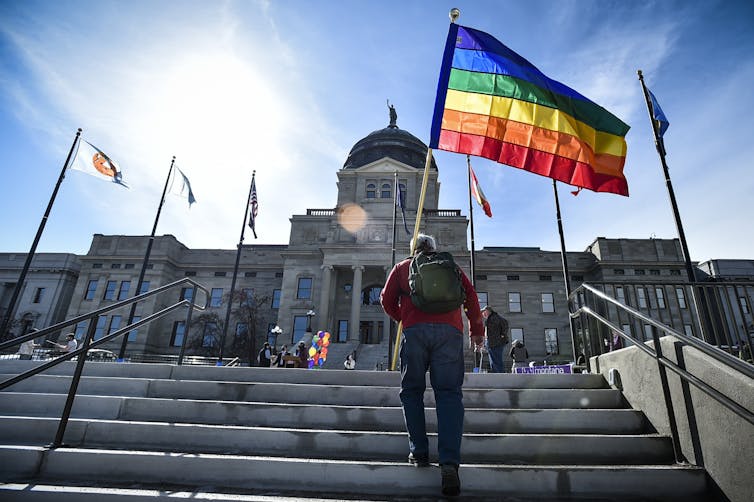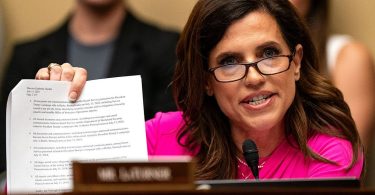Donald Trump’s victory in last week’s US election has sent shockwaves through the LGBTQ+ community, given the president-elect’s divisive rhetoric and demonisation of the trans community in particular.
There are fears a second Trump administration will have devastating effects for millions of LGBTQ+ people in the United States and beyond.
What could Trump do while in office? The Project 2025 policy manifesto provides some clues.
A blueprint for discrimination
Written by the Heritage Foundation, a conservative think tank, Project 2025 is a playbook for the next conservative president.
It contains input from more than 110 groups on key policy and personnel recommendations. The intention is to act quickly. It features a 180-day action plan that “includes a comprehensive, concrete transition plan for each federal agency”.
Trump sought to distance himself from the manifesto during the campaign. However, many of the contributors played roles in Trump’s first term in office. This includes Stephen Miller, who is expected to be named deputy chief of staff for policy in his second term. Miller’s group, America First Legal, has backed Project 2025.
In 2022, Trump also said of the Heritage Foundation plans:
This is a great group, and they’re going to lay the groundwork and detail plans for exactly what our movement will do and what your movement will do when the American people give us a colossal mandate to save America.
The Project 2025 manifesto advocates the removal of anti-discrimination policies that protect the LGBTQ+ community. According to the American Civil Liberties Union (ACLU), this means removing all federal regulations and rules prohibiting discrimination on the basis of sexual orientation and gender identity.
Specifically, Project 2025 aims to limit the application of a Supreme Court ruling protecting people from workplace discrimination on the basis of sexual orientation and transgender status.
The plan also calls for the reversal of policies allowing transgender people to serve in the military. And it advocates blocking gender-affirming medical care for transgender people in federal health care programs, such as Medicare.
Its authors also aim to wind back the Biden administration’s executive order promoting gender equity and sexual and reproductive health and rights.
The manifesto’s foreword says that in America today,
children suffer the toxic normalisation of transgenderism with drag queens and pornography invading their school libraries.
Particularly troubling is the suggestion transgender identity and drag queens are synonymous with an unclear definition of “pornography”. The document further recommends educators and public librarians who “purvey pornography” be classed as registered sex offenders.
The plan does not specifically target marriage equality. However, there are mentions of the “biblically based” definition of marriage and family. Some believe this treats same-sex unions as “second-class marriages”.

John Minchillo/AP
Trump’s record on LGBTQ+ issues
Looking beyond Project 2025, there are other worrying signs Trump will not be a president acting in the best interests of LGBTQ+ Americans.
His appointment of anti-LGBTQ+ judges during his first presidency has already created a judicial climate hostile to LGBTQ+ people and people living with HIV.
While president, Trump also opposed a proposed Equality Act. It would have provided consistent and explicit anti-discrimination protections for LGBTQ+ people across key areas of life, including employment, housing and education. The act was reintroduced by Democrats last year and has failed to pass the Senate.
During his first term in office, Trump also:
- supported employment discrimination against LGBTQ+ people
- banned transgender people from serving in the military, and
- rolled back Obama-era non-discrimination protections.
In addition, his anti-LGBTQ+ slurs feed antagonism and divisiveness that lead to increases in hate speech.
In 2017, for instance, Trump reportedly joked his vice president, Mike Pence, wanted to “hang” gay people. (The White House denied the remark.)
Attack on LGBTQ+ rights at state level
The ideology driving some of the anti-LGBTQ+ proposals in Project 2025 is already highly visible at the state level in the US.
In 2024 alone, the ACLU has tracked 532 anti-LGBTQ+ bills across the US. These include:
- 208 bills restricting student and educator rights
- 70 bills on religious exemptions
- 112 on healthcare restrictions, and
- 34 free speech and expression bans (including 27 drag bans).

Thom Bridge/Independent Record/AP
Protests against drag queen story-time childhood literacy events have led to increased scrutiny of public libraries, as well as false claims such events are being funded by taxpayers.
After pressure from conservative activists, corporations have also withdrawn from commitments to LGBTQ+ inclusion. For some, this includes not participating in the Human Rights Campaign’s Corporate Equality Index.
Constitutional challenges
In addition, the ACLU warns the Trump administration could weaponise federal law against transgender people. For instance, the group says, it could override critical state-level protections, arguing state laws that protect transgender students violate the federal statutory rights of non-transgender students.
The ACLU has also voiced concerns the Trump administration could take the “extreme position” the US Constitution entitles employers to discriminate against LGBTQ+ people based on employer religious beliefs, notwithstanding state nondiscrimination laws.
Many of the anti-LGBTQ+ polices outlined in Project 2025 would likely violate the Constitution and federal law. Organisations like the ACLU could then use the courts to challenge any Trump executive orders or other policy changes.
And Congress can still use its oversight and investigatory roles to constrain the Trump administration’s agenda. However, Republicans now hold a majority in the Senate and may have a majority in the House of Representatives.
This means activists hoping to challenge anti-LGBTQ+ policies will need a well-coordinated pro-equality action coalition at the federal, state and local levels in order to drive change and block any discriminatory policies that may arise during Trump’s second term.






